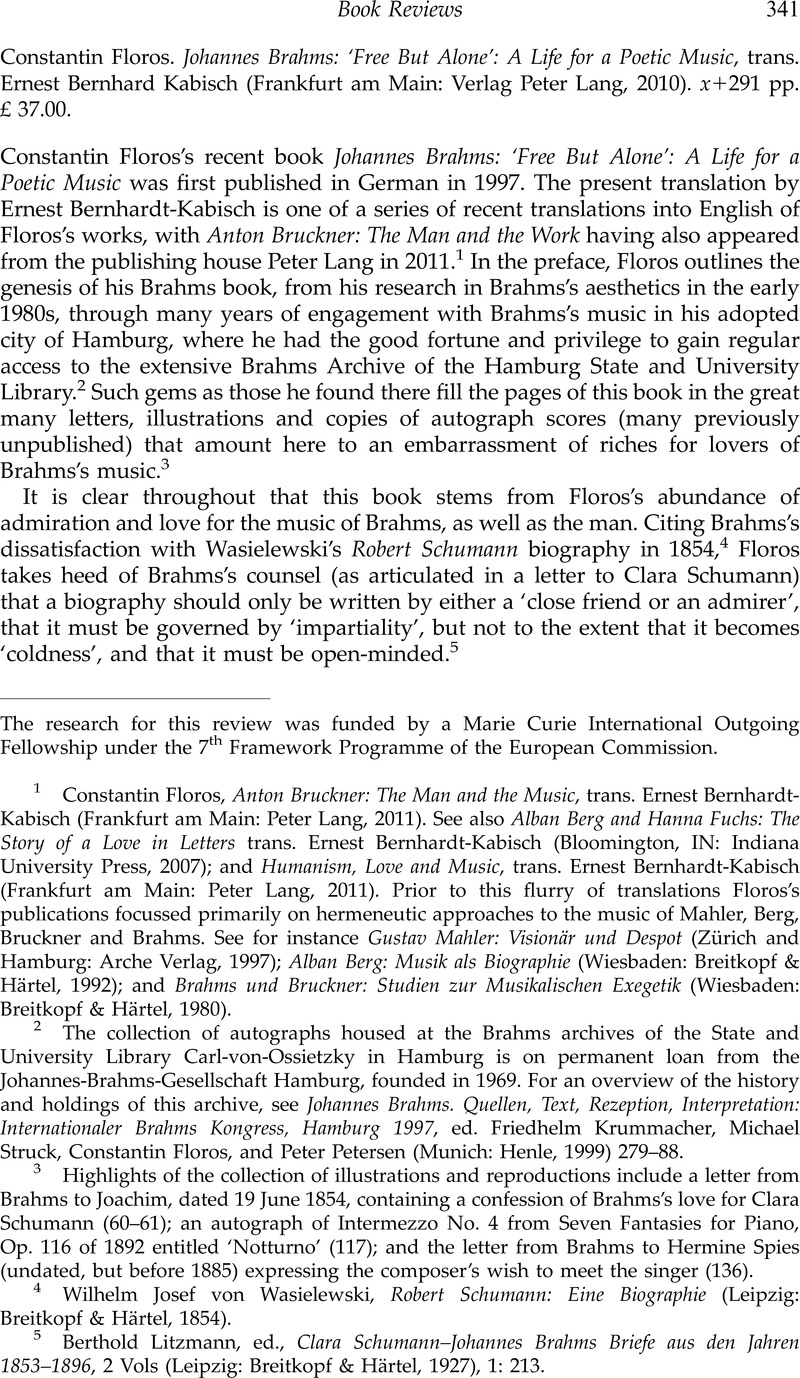No CrossRef data available.
Article contents
Constantin Floros. Johannes Brahms: ‘Free But Alone’: A Life for a Poetic Music, trans. Ernest Bernhard Kabisch (Frankfurt am Main: Verlag Peter Lang, 2010). x+291 pp. £ 37.00.
Published online by Cambridge University Press: 08 January 2013
Abstract

- Type
- Book Reviews
- Information
- Copyright
- Copyright © Cambridge University Press 2012
References
The research for this review was funded by a Marie Curie International Outgoing Fellowship under the 7th Framework Programme of the European Commission.
1 Constantin Floros, Anton Bruckner: The Man and the Music, trans. Ernest Bernhardt-Kabisch (Frankfurt am Main: Peter Lang, 2011)Google Scholar
2 The collection of autographs housed at the Brahms archives of the State and University Library Carl-von-Ossietzky in Hamburg is on permanent loan from the Johannes-Brahms-Gesellschaft Hamburg, founded in 1969. For an overview of the history and holdings of this archive, see Johannes Brahms. Quellen, Text, Rezeption, Interpretation: Internationaler Brahms Kongress, Hamburg 1997, ed. Friedhelm Krummacher, Michael Struck, Constantin Floros, and Peter Petersen (Munich: Henle, 1999) 279–88.
3 Highlights of the collection of illustrations and reproductions include a letter from Brahms to Joachim, dated 19 June 1854, containing a confession of Brahms's love for Clara Schumann (60–61); an autograph of Intermezzo No. 4 from Seven Fantasies for Piano, Op. 116 of 1892 entitled ‘Notturno’ (117); and the letter from Brahms to Hermine Spies (undated, but before 1885) expressing the composer's wish to meet the singer (136).
4 Wilhelm Josef von Wasielewski, Robert Schumann: Eine Biographie (Leipzig: Breitkopf & Härtel, 1854)Google Scholar
5 Berthold Litzmann, ed., Clara Schumann–Johannes Brahms Briefe aus den Jahren 1853–1896, 2 Vols (Leipzig: Breitkopf & Härtel, 1927), 1: 213Google Scholar
6 The four new chapters are Chapter 12, ‘Tradition and Innovation in the First Symphony’, (141–8); Chapter 14, ‘Mortality, Consolation and Hope as Semantic Fields in A German Requiem’, (155–66); Chapter 15, ‘“Even the Beauteous Must Die”: Nänie’, (167–79); and Chapter 16, ‘Four Serious Songs’, (180–85).
7 McClary, Susan, ‘Narrative Agendas in “Absolute” Music: Identity and Difference in Brahms's Third Symphony’, in Musicology and Difference: Gender and Sexuality in Music Scholarship, ed. Ruth Solie (Berkeley: University of California Press, 1993)Google Scholar
Bozarth, George, ‘Brahms's “Lieder ohne Worte”: The “poetic” Andantes of the Piano Sonatas’, in Brahms Studies: Analytical and Historical Perspectives, ed. George Bozarth (Oxford: Clarendon, 1990)Google Scholar
8 Cone, Edward T., ‘Brahms: Songs with Words and Songs Without Words’, Integral 1 (1987): 31–56Google Scholar
Brodbeck, David, Brahms, Symphony No. 1 (Cambridge: Cambridge University Press, 1993)Google Scholar
Brodbeck, David, ‘Medium and Meaning: New Aspects of the Chamber Music’, in the Cambridge Companion to Brahms, ed. Michael Musgrave (Cambridge: Cambridge University Press, 1999): 98–132Google Scholar
Fink, Robert, ‘Desire, Repression, and Brahms's First Symphony’, Repercussions 2 (1993): 78–103Google Scholar
Smith, Peter H., Expressive Forms in Brahms's Instrumental Music: Structure and Meaning in His Werther Quartet (Bloomington: Indiana University Press, 2005)Google Scholar
9 Kross, Siegfried, ‘Brahms und Schumann’, Brahms Studien 4 (1981): 7–44Google Scholar
10 Russell, Peter, Johannes Brahms and Klaus Groth: The Biography of a Friendship (Aldershot: Ashgate, 2006)Google Scholar
11 The discussion of Brahms's allusion to Schumann's Manfred receives more comprehensive treatment in Brodbeck, Brahms, Symphony No. 1; and whereas in 1997 Schumann's Manfred may have been ‘relatively little analyzed’, Laura Tunbridge has done an excellent job since then in her ‘Schumann's “Manfred” in the Mental Theatre’, Cambridge Opera Journal 15 (July 2003): 153–83.
12 Hatten, Robert, Musical Meaning in Beethoven: Markedness, Correlation, and Interpretation (Bloomington: Indiana University Press, 1994)Google Scholar
13 Currently housed at Upper Belvedere, Vienna.
14 Currently housed at the Staatliche Museen zu Berlin.
15 ‘Doch war es weniger diese Musikliebe, als vielmehr die Ähnlichkeit in der ganzen Kunstanschauung, was Feuerbach mit Brahms in Freundschaft und Seelenverwandschaft verband’. Eduard Hanslick, ‘Nänie’, Concerte, Componisten und Virtuosen, 376 (my translation).
16 ‘...dieselbe unerschütterliche Richtung auf das Große, Erhabene und Ideale, die oft bis zur herben Strenge und Abgeschlossenheit führte’. Hanslick, ‘Nänie’, Concerte, Componisten und Virtuosen, 376.
17 The Hanslick review from which Floros cites is Hanslick, ‘Neue Klavierstücke von Brahms’, Fünf Jahre Musik, 1891–1895: Kritiken (Berlin: Allgemeiner Verein für Deutsche Literatur, 1896), 257–59.
18 Nicole Grimes, ‘Brahms's Poetic Allusions through Hanslick's Critical Lens’, American Brahms Society Newsletter 24/2 (Fall 2011): 5–9Google Scholar
Struck, Michael, ‘Revisionsbedürftig: Zur gedruckten Korrespondenz von Johannes Brahms und Clara Schumann: Auswirkungen irrtümlicher oder lückenhafter Überlieferung auf werkgenetische Bestimmungen (mit einem unausgewerteten Brahms-Brief zur Violinsonate Op. 78’, Die Musikforschung 41/3 (1988): 235–41Google Scholar
Ben Kohn and George Bozarth as ‘New Evidence of the Genesis of Brahms's G minor Violin Sonata, Op. 78’, American Brahms Society Newsletter 9/1 (Spring 1991): 5–6Google Scholar
19 For example, ‘Through an eccentric rhythmic structure he transmutes the three-fourth beat repeatedly into a two-fourth one’. (85) See also 50, 105.




